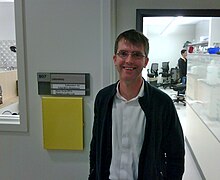| Drew Endy | |
|---|---|
 | |
| Born | 1970 (age 54–55) |
| Alma mater | Dartmouth College |
| Spouse | Christina Smolke |
| Scientific career | |
| Fields | Synthetic biology |
| Institutions | Stanford University Massachusetts Institute of Technology Dartmouth College |
| Thesis | Development and application of a genetically-structured simulation for bacteriophage T7 (1997) |
| Doctoral advisor | John Yin |
| Website | openwetware engineering |
Andrew (Drew) David Endy (born 1970) is a synthetic biologist and tenured associate professor of bioengineering at Stanford University, California.
Education
Endy received his PhD from Dartmouth College in 1997 for his work on genetic engineering using T7 phage.
Career
Endy was a junior fellow for three years and later an Assistant Professor of Biological Engineering at the Massachusetts Institute of Technology (2002–2008). In 2008, Endy moved to Stanford University, where he currently serves as an Associate Professor of Bioengineering.
Research
With Thomas Knight, Gerald Jay Sussman, Randy Rettberg, and others at MIT, Endy worked on synthetic biology and the engineering of standardized biological components, devices, and parts, collectively known as BioBricks. Endy is one of several founders of the Registry of Standard Biological Parts, and invented an abstraction hierarchy for integrated genetic systems.
Endy has been one of the early promoters of open source biology, and helped start the Biobricks Foundation, a not-for-profit organization that will work to support open-source biology. He was also a co-founder of the now defunct Codon Devices, a biotechnology startup company that aimed to commercialize synthetic biology.
In 2009, Michael Specter called Endy "synthetic biology’s most compelling evangelist" in his book Denialism: How Irrational Thinking Hinders Scientific Progress, Harms the Planet, and Threatens Our Lives, as Endy is persistent in discussing both the prospects and dangers of synthetic biology.
Endy headed a team of researchers that in March 2013 created the biological equivalent of a transistor, which they dubbed a "transcriptor". The invention was the final of the three components necessary to build a fully functional biocomputer: data storage, information transmission, and a basic system of logic.
Endy is a founder and steering group member of the Build-a-Cell Initiative, an international collaboration investigating creation of synthetic live cells.
References
- Endy, D.; Kong, D.; Yin, J. (1997). "Intracellular kinetics of a growing virus: A genetically structured simulation for bacteriophage T7". Biotechnology and Bioengineering. 55 (2): 375–389. doi:10.1002/(SICI)1097-0290(19970720)55:2<375::AID-BIT15>3.0.CO;2-G. PMID 18636496.
- "365 days: Nature's 10". Nature. 528 (7583): 459–467. 2015. Bibcode:2015Natur.528..459.. doi:10.1038/528459a. PMID 26701036.
- Endy, D. (2005). "Foundations for engineering biology". Nature. 438 (7067): 449–453. Bibcode:2005Natur.438..449E. doi:10.1038/nature04342. PMID 16306983. S2CID 1436520.
- Colman-Lerner, A.; Gordon, A.; Serra, E.; Chin, T.; Resnekov, O.; Endy, D.; Gustavo Pesce, C.; Brent, R. (2005). "Regulated cell-to-cell variation in a cell-fate decision system". Nature. 437 (7059): 699–706. Bibcode:2005Natur.437..699C. doi:10.1038/nature03998. PMID 16170311. S2CID 4398874.
- Endy, D.; Yaffe, M. B. (2003). "Signal transduction: Molecular monogamy". Nature. 426 (6967): 614–615. Bibcode:2003Natur.426..614E. doi:10.1038/426614a. PMID 14668845.
- Endy, D.; Brent, R. (2001). "Modelling cellular behaviour". Nature. 409 (6818): 391–395. Bibcode:2001Natur.409..391E. doi:10.1038/35053181. PMID 11201753.
- Drew Endy publications indexed by Microsoft Academic
- Drew Endy at DBLP Bibliography Server

- Canton, B.; Labno, A.; Endy, D. (2008). "Refinement and standardization of synthetic biological parts and devices". Nature Biotechnology. 26 (7): 787–793. doi:10.1038/nbt1413. PMID 18612302. S2CID 19797363.
- Endy, Andrew David (1997). Development and application of a genetically-structured simulation for bacteriophage T7 (PhD thesis). Dartmouth College. ProQuest 304348966.
- "Stanford Engineering: Drew Endy". Stanford.edu. Retrieved 1 December 2021.
- Platoni, Kara (16 December 2011). "Assembly Required". Stanfordmag.org. Stanford Magazine. Retrieved 1 December 2021.
- Shetty, R. P.; Endy, D.; Knight, T. F. (2008). "Engineering BioBrick vectors from BioBrick parts". Journal of Biological Engineering. 2: 5. doi:10.1186/1754-1611-2-5. PMC 2373286. PMID 18410688.
- From the cells up, The Guardian, 10 March 2005
- Lohr, Steve (November 23, 2021). "Can Synthetic Biology Save Us? This Scientist Thinks So". New York Times. Retrieved 1 December 2021.
- Check Hayden, Erika; Ledford, Heidi (April 16, 2009). "A synthetic-biology reality check" (PDF). Nature. No. 458. Retrieved 1 December 2021.
- Specter, Michael (2009). Denialsim How Irrational Thinking Hinders Scientific Progress, Harms the Planet, and Threatens Our Lives. Penguin Group. pp. 242–253. ISBN 978-1-59420-230-8.
- Robert T. Gonzalez (March 29, 2013). "This new discovery will finally allow us to build biological computers". IO9. Retrieved March 29, 2013.
- "Build-a-Cell". Retrieved 4 Dec 2020.
External links
- Lab webpage
- Personal page on OpenWetWare for Drew Endy
- Abstraction hierarchy for integrated genetic systems
- Steal This Genome
- Biology Yearns to be Free
- Gen9
- Article on the commercialization of DNA synthesis
- Registry of Standard Biological Parts
- Interview with Drew Endy in Edge - the third culture
- Northwestern Silverstein Lecture